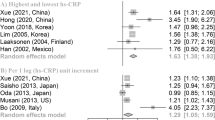Abstract
To compare high-sensitivity C-reactive protein (hs-CRP) and white blood cell count (WBC) as a predictor of metabolic syndrome (MetS). Hazard ratios (HRs) adjusted for age, smoking, and other confounding covariates and areas under receiver operating characteristic curve (AUCs) of hs-CRP and WBC for developing MetS were calculated in 1,463 men and 920 women from a Japanese health screening population who were free from MetS, diabetes, histories of coronary heart disease, and stroke at baseline and followed through 3 years. The adjusted HRs (95% confidence interval—CI; p value) of MetS for each 1 SD increases in log hs-CRP, and log WBC were 1.345 (1.166–1.553; <0.001) and 1.406 (1.188–1.664; <0.001), respectively, in men and 1.388 (1.110–1.736; 0.004) and 1.358 (1.072–1.721; 0.011), respectively, in women. However, the HRs became nonsignificant after further adjusted for the components of MetS. The AUCs (95% CI; p value) of hs-CRP and WBC for predicting MetS were 0.616 (0.573–0.660; <0.001) and 0.613 (0.566–0.659; <0.001), respectively, in men and 0.636 (0.573–0.698; <0.001) and 0.606 (0.538–0.673; 0.003), respectively, in women. Hs-CRP and WBC equally predict development of MetS, but both are poor predictors of MetS in a Japanese health screening population where obesity is not prevailing.
Similar content being viewed by others
References
Oda E (2012) Metabolic syndrome: its history, mechanisms, and limitations. Acta Diabetol 49:89–95
World Health Organization (1999) Definition, diagnosis, and classification of diabetes mellitus and its complications: report of a WHO Consultation. World Health Org, Geneva
Expert Panel on the Detection, Evaluation, and Treatment of High Blood Cholesterol in Adults (2001) Executive summary of the third report of the National Cholesterol Education Program (NCEP) expert panel on detection, evaluation, and treatment of high blood cholesterol in adults (adult treatment panel III). JAMA 285:2486–2497
Alberti KGMM, Zimmet P, Shaw J (2006) Metabolic syndrome—a new world-wide definition. A consensus statement from the International Diabetes Federation. Diabet Med 223:469–480
Grundy SM, Cleeman JI, Daniels SR et al (2005) Diagnosis and management of the metabolic syndrome: a statement for health care professionals: an American Heart Association/National Heart, Lung, and Blood Institute Scientific Statement. Circulation 112:2735–2752
Alberti KG, Eckel RH, Grundy SM et al (2009) Harmonizing the metabolic syndrome. A joint interim statement of the International Diabetes Federation Task Force on Epidemiology and Prevention; National Heart, Lung, and Blood Institute; American Heart Association; World Heart Federation; International Atherosclerosis Society; and International Association for the Study of Obesity. Circulation 120:1640–1645
Kahn R, Buse J, Ferrannini E, Stern M (2005) The metabolic syndrome: time for a critical appraisal: joint statement from the American Diabetes Association and the European Association for the Study of Diabetes. Diabetes Care 28:2289–2304
Simmons RK, Alberti KG, Gale EA et al (2010) The metabolic syndrome: useful concept or clinical tool? Report of a WHO expert consultation. Diabetologia 53:600–605
Weisberg SP, McCann D, Desai M, Rosenbaum M, Leibel RL, Ferrante AW Jr (2003) Obesity is associated with macrophage accumulation in adipose tissue. J Clin Invest 112:1796–1808
Cinti S, Mitchell G, Barbatelli G et al (2005) Adipocyte death defines macrophage localization and function in adipose tissue of obese mice and humans. J Lipid Res 46:2347–2355
Kim J, Montagnani M, Koh KK, Quon MJ (2006) Reciprocal relationships between insulin resistance and endothelial dysfunction. Molecular and pathophysiological mechanisms. Circulation 113:1888–1904
Hotamisligil GS, Shargill NS, Spiegelman BM (1993) Adipose expression of tumor necrosis factor-α: direct role in obesity-linked insulin resistance. Science 259:87–91
Dandona P, Aljada A, Chaudhuri A, Mohanty P, Garg R (2005) Metabolic syndrome: a comprehensive perspective based on interactions between obesity, diabetes, and inflammation. Circulation 111:1448–1454
Hansson GK (2005) Inflammation, atherosclerosis, and coronary artery disease. N Engl J Med 352:1685–1695
Ridker PM, Wilson PWF, Grandy SM (2004) Should C-reactive protein be added to metabolic syndrome and to assessment of global cardiovascular risk? Circulation 109:2818–2825
Tamakoshi K, Toyoshima H, Yatsuya H et al (2007) White blood cell count and risk of all-cause and cardiovascular mortality in nationwide sample of Japanese. Results from NIPPON DATA90. Circ J 71:479–485
Fadini GP, Marcuzzo G, Marescotti MC, de Kreutzenberg SV, Avogaro A (2012) Elevated white blood cell count is associated with prevalence and development of the metabolic syndrome and its components in the general population. Acta Diabetol 49:445–451
Oda E, Kawai R (2010) Comparison between high-sensitivity C-reactive protein (hs-CRP) and white blood cell count (WBC) as an inflammatory component of metabolic syndrome in Japanese. Intern Med 49:117–124
Reaven GM (1988) Role of insulin resistance in human disease. Diabetes 37:1595–1607
Nagasawa N, Tamakoshi K, Yatsuya H et al (2004) Association of white blood cell count and clustered components of metabolic syndrome in Japanese men. Circ J 68:892–897
Jung CH, Lee WY, Kim SY et al (2008) The risk of metabolic syndrome according to the high-sensitivity C-reactive protein in apparently healthy Koreans. Int J Cardiol 129:266–271
Margolis KL, Manson JE, Greenland P et al (2005) Women’s Health Initiative Research Group: leukocyte count as a predictor of cardiovascular events and mortality in postmenopausal women—the Women’s Health Initiative Observational Study. Arch Intern Med 165:500–508
Oda E, Kawai R (2009) Very low levels of high-sensitivity C-reactive protein are not bimodaly distributed but significantly related with other metabolic risk factors in Japanese. Intern Med 48:953–958
Acknowledgments
The author thanks all subjects who participated in the study, the paramedical staff at our center who assisted with the study and Honorary Prof. Yoshifusa Aizawa at Tachikawa Medical Center for his instructive comments.
Conflict of interest
None.
Author information
Authors and Affiliations
Corresponding author
Additional information
Communicated by Massimo Federici.
Rights and permissions
About this article
Cite this article
Oda, E. High-sensitivity C-reactive protein and white blood cell count equally predict development of the metabolic syndrome in a Japanese health screening population. Acta Diabetol 50, 633–638 (2013). https://doi.org/10.1007/s00592-013-0477-7
Received:
Accepted:
Published:
Issue Date:
DOI: https://doi.org/10.1007/s00592-013-0477-7




